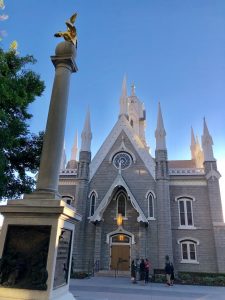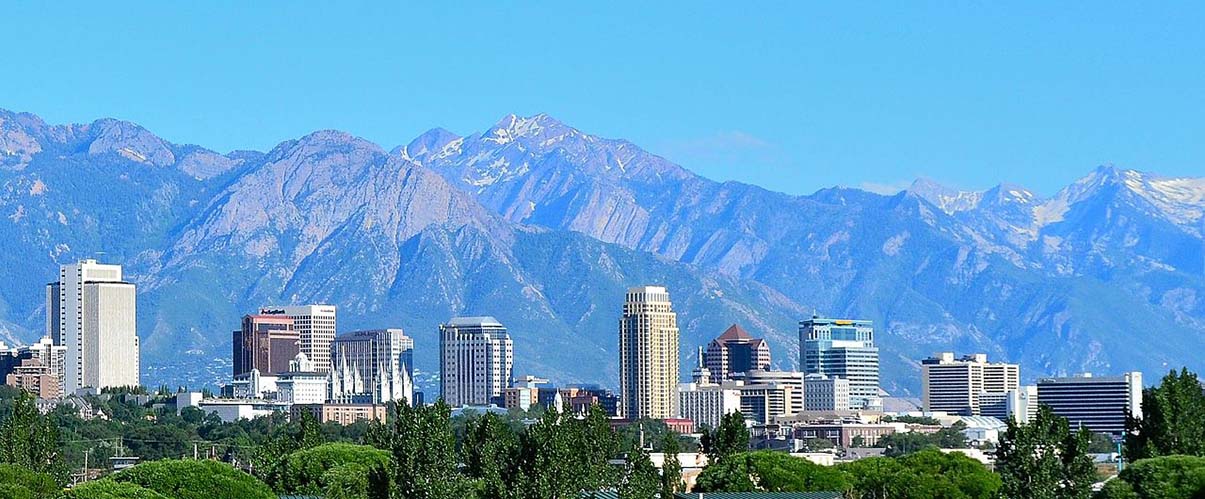
by Saul Schwartz
With a population of just under 200,000, SLC is Utah’s most populous city, with a metropolitan area estimated to have over one million residents. Views from SLC are spectacular with the snow-capped Wasatch Mountains to the east and the Oquirrh Mountains to the west.
Temple Square
Temple Square is the headquarters for Church of Jesus Christ of Latter Day Saints. The Church provides many wonderful performances on Temple Square, open to the public, regardless of religion.
This 35 acre three block area contains the principal buildings of the Church, statues and several memorials. On the grounds we first saw that there are two statues of Joseph and Hyrum Smith near the South Visitor Center. They were completed in 1911. We learned that the Smith brothers were the original religious leaders of the Church and that they were killed in Illinois by an anti-church mob. The Seagull Monument sits outside the Assembly Hall. Bronze seagulls sit on top of the monument. The monument is a reference to Mormon folklore where seagulls devoured insects that were destroying the first crops planted by Church pioneers in the Salt Lake Valley in 1848. www.templesquare.com
Salt Lake Temple
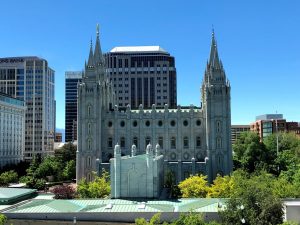 The beautiful Temple sits in the middle of Temple Square at 50 North West Temple Street and is a massive focal point of the square. Only members of the Church of Latter Day Saints are allowed entry into the Temple. Even though the building is not open to the public, the exterior is definitely worth viewing for its stunning exterior workmanship and sheer scale. Begun in 1853 when Brigham Young laid the cornerstone and completed in 1893, the neo-Gothic temple cost $4 million to build. Atop the 210-foot east tower is a gold leaf angel (Moroni) that Joseph Smith said visited him on numerous occasions. The worldwide icon was constructed by Mormon pioneers who sacrificed time, labor and material goods to create a symbol of their faith and devotion.
The beautiful Temple sits in the middle of Temple Square at 50 North West Temple Street and is a massive focal point of the square. Only members of the Church of Latter Day Saints are allowed entry into the Temple. Even though the building is not open to the public, the exterior is definitely worth viewing for its stunning exterior workmanship and sheer scale. Begun in 1853 when Brigham Young laid the cornerstone and completed in 1893, the neo-Gothic temple cost $4 million to build. Atop the 210-foot east tower is a gold leaf angel (Moroni) that Joseph Smith said visited him on numerous occasions. The worldwide icon was constructed by Mormon pioneers who sacrificed time, labor and material goods to create a symbol of their faith and devotion.
The temple is about to undergo major renovations later this year. The exterior contains six spires that reach towards the heavens. It is especially beautiful to view the Temple at night with its lights. Even the four sets of large solid oak Temple doors are decorated with religious symbols. This Temple is the largest Mormon temple based on its floor area.
Mormon Tabernacle Choir
Performances are complimentary. Tickets are not required for most performances. You can attend a two hour choir rehearsal which either takes place in the Tabernacle or the Conference Center, depending on the time of the year. Most rehearsals are on Thursdays at 7:30 p.m. The choir formed in the mid nineteenth century. The choir’s 360 volunteer singers are all members of the Church. Their collective voices are truly glorious.
We attended a live broadcast of “Music and the Spoken Word.” The thirty minute weekly broadcast takes place on Sundays at 9:30 a.m. The program includes the renowned Choir and Orchestra. These performances are either in the Tabernacle or the Conference Center, again depending on the time of year. Tickets are normally not required and there is no fee for admission. This program is the world’s longest continuing network broadcast show and is available through live streaming on the internet, as well as on more than 2000 television, cable outlets and radio stations worldwide. We attended show number 4682. The first broadcast took place on July 15, 1929. www.mormontabernaclechoir.org.
Conference Center
We attended the Choir performance of “Music and the Spoken Word” in the Conference Center, which seats 21000. This show consisted of seven pieces, including an American folk hymn, music from West Side Story and several inspirational religious works. In addition, Lloyd Newell announced the spoken word portion of the broadcast, focusing on humility.
The 7708 pipe organ in the Conference Center was built from 2000 to 2003. This organ of the American Romantic style employs a symphonic tonal approach with the richness and warmth characteristic of English instruments. Although designed primarily to provide colorful and varied accompaniment, the organ also renders the solo repertoire beautifully.
After the performance, we attended a free one and one half hour tour of the massive Conference Center with one of the Church volunteers. Completed in 2000, the conference center is used for the Church’s national conferences. The tour is an opportunity to see an excellent collection of original art. One group of paintings focuses on scenes from the Book of Mormon by Arnold Friberg. The rooftop garden offers a panoramic view of the Salt Lake Valley. Other galleries feature portraits of current and past Church leaders.
An Organ Recital in the Tabernacle
The Salt Lake Tabernacle is located at 50 West North Temple Street. Completed in 1867, the Tabernacle seats 6500 under one of the world’s largest dome roofs without center support. The building has remarkable acoustics.
Thirty minute organ recitals are held daily at either Noon or 2 p.m. or at both times. There is no charge for admission. Temple Square supports a long-standing tradition of fine organ music with amazing organs. We attended a performance by guest organist Ikuko Weller. She first explained the wonderful acoustics in the Tabernacle by a demonstration showing how well we could hear the tearing of a newspaper or the dropping of a nail or pin without the use of a microphone. She then performed a series of seven pieces, two of which she arranged herself.
The organ in the Tabernacle was originally constructed by pioneer organ builder Joseph Ridges in the 1860s. It has been rebuilt and enlarged throughout the years, most notably in 1948. This organ is recognized by many as a quintessential example of the American Classic style of organ building, an eclectic approach. This huge organ contains 11,623 pipes and is said to be one of the finest organs in existence today.
We watched a portion of a flute recital in the Assembly Hall. Again there is no charge for admission. The hall seats about 1400. The hall’s exterior looks like a small gothic cathedral with 24 spires. We were particularly interested to see the Stars of David above each entrance. Constructed in 1877, the Assembly Hall is now primarily used for music concerts and as an overflow site for Church conferences.
The Assembly Hall organ was influenced by organs of the seventeenth and eighteenth centuries. Installed in 1983, this organ features mechanical key action, clear ensembles voiced on low wind pressure and a classically inspired tonal palette. The organ contains 3489 pipes.
Joseph Smith Memorial Building
Located at 15 East South Temple Street, this building is named for the first president of the Church. The building has been renovated, as it was operated as the Utah Hotel from 1911 to 1987. The elegant lobby contains decorative features such as marble columns, art glass and an impressive staircase. A Church volunteer took us on a short guided tour, which included the lobby and second floors. In 1993, the building reopened as a social center for the Church.
There is a small chapel within the building on the second floor. In the chapel, there is an organ with 2484 pipes built by a French-Canadian firm in 1993. This instrument is decidedly French in its tonal orientation, yet it has the versatility to render a wide range of repertoire.
The Smith building contains three separate restaurants. Short films are shown about the Church in a theater within the building.
Family History Library
We spent three hours in the fascinating genealogy center tracing our family trees with assistance from Church volunteers. In 2013, the Church opened the Family Search with the world’s largest amount of genealogy records. The search is free and there were plenty of computer terminals available to us.
Temple Square Tour
We attended a free 45 minute tour given by one of the Church missionaries. Church volunteers answer questions and explained the pioneers’ historic trip trek from Illinois to the Salt Lake Valley and why it took 40 years to build the Salt Lake Temple. It was largely due to the fact that the temple was built out of solid granite from a canyon 20 miles away from SLC. Under the leadership of Brigham Young, construction was halted until the railroad was built which dramatically reduced the delivery time for the materials. We briefly went inside several of the Temple Square buildings during this tour and viewed a number of the outdoor statutes.
Beyond Temple Square
Beehive House
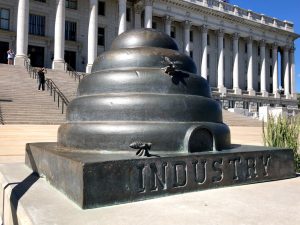 Just outside Temple Square, this house is located at 67 East Temple Street. The 1854 house is the restored official residence of Brigham Young, the second president of the Mormon Church. The house is decorated with period furnishings which show how the Young family lived in the 1850s. An image of a beehive, the state symbol of industry and a reference to Young’s worth ethic, sits on top of the house.
Just outside Temple Square, this house is located at 67 East Temple Street. The 1854 house is the restored official residence of Brigham Young, the second president of the Mormon Church. The house is decorated with period furnishings which show how the Young family lived in the 1850s. An image of a beehive, the state symbol of industry and a reference to Young’s worth ethic, sits on top of the house.
We attended a free 30 minute guided tour where we learned that Young served as Utah’s territorial governor. An interesting map in the house from this period shows how the Utah territory encompassed land well beyond its current state borders. Young helped establish Mormon pioneer settlements throughout the west.
Utah State Capitol
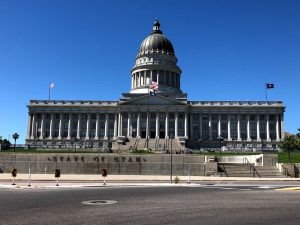 We made our way up SLC’s Capitol Hill to 350 North State Street for a self-guided tour of the Capitol building. The Capitol overlooks Salt Lake Valley from Capitol Hill. The Corinthian-style structure was built in 1916 of Georgia marble and Utah granite. The top consists of a huge copper-covered dome. Outside are several beehives representing the state symbol.
We made our way up SLC’s Capitol Hill to 350 North State Street for a self-guided tour of the Capitol building. The Capitol overlooks Salt Lake Valley from Capitol Hill. The Corinthian-style structure was built in 1916 of Georgia marble and Utah granite. The top consists of a huge copper-covered dome. Outside are several beehives representing the state symbol.
Inside the Capitol there are a main hall and rotunda with historical wall and ceiling murals. The State Reception Room is particularly attractive with its lavish furnishings and extensive use of gold leaf. We learned that the state was originally proposed by the Church of Latter Day Saints to be called Deseret, meaning honeybee. The Capitol building is open seven days per week, except for holidays.
At the conclusion of our five days in SLC, we determined that the city had some of the friendliest residents of any metropolitan area that we have visited. In particular, the missionaries and volunteers from the Church of Latter Day Saints provided us with extensive information about the Church without us feeling any obligation to become interested in conversion. SLC provides many more outstanding attractions without charge than most other U.S. cities.
If You Go:
Visitor’s Centers
LDS Visitor Centers are located in the northwest and southeast corners of Temple Square. Church volunteers are available within each visitor center to answer questions from the public about their religion.
Interactive exhibits in the North Visitor Center focus on the life, gospel and teachings of Jesus Christ. The starry dome of this center is highlighted by an eleven foot tall statue of Jesus Christ (called Christis). Interesting exhibits include biblical murals and a scale model of how Jerusalem appeared during the lifetime of Jesus.
Exhibits in the South Visitor Center focus on the importance of religion on families and on the Salt Lake Temple. Since the Temple is only open to members of the Church of Latter Day Saints, this is an opportunity to view a detailed model of the inside of the Temple and artifacts about the construction of the temple.
We enjoyed an elegant dinner overlooking Temple Square at The Roof Restaurant. This restaurant offers a fine dining buffet on the tenth floor of the Joseph Smith Memorial Building. The buffet was extremely extensive and the views of the Temple Square buildings were dramatic as day turned into night.
We twice chose a lighter dinner at the Nauvoo Café in the lobby level of the Joseph Smith Memorial Building. The café offers sandwiches and salads in a more casual setting, without waiters. The sandwich breads were especially tasty. www.diningattemplesquare.com
Coffee Break
For a coffee/tea break, we stopped in at Nostalgia Café on 248 E. 100 South Street. This cute café is midway between the Capitol and Temple Square. In addition to drinks, a limited food menu is available, with both indoor and outdoor seating options.
Tips
Downtown streets are based on a grid system with Temple Square at the center. The light rail system (TRAX) provides three lines. Riding TRAX is free within the downtown area and there are several stops right next to Temple Square.
Pedestrian friendly City Creek Center at 50 Main Street includes a large foot court, stand-alone restaurants and about 100 upscale stores. The Center is decorated with a foliage lined creek that runs throughout the site. It is located directly across from Temple Square.
Lodging in the downtown near Temple Square makes sightseeing easier. The Grand America Hotel at 555 South Main Street is inspired by the charm of Europe’s classic hotels. The hotel was crafted from fine materials, such as Italian chandeliers, marble, West African woods and French tapestries. The rooms are extremely spacious and tasteful. The hotel offers several restaurant options, an outdoor pool and an extensive fitness center. The common areas are decorated with museum quality art and sculpture. Nearby, the less expensive Doubletree Suites at 110 West 600 South Street also provides spacious rooms, a nice fitness center and breakfast options.
Harmon’s grocery stores are located throughout SLC and provide an excellent alternative to restaurants. After our purchase, we had a meal just outside the store in one of their seating areas.
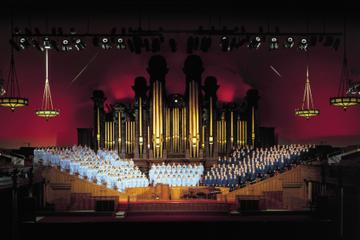
Salt Lake City Tour and Mormon Tabernacle Choir Performance
About the author:
Saul Schwartz lives in Alexandria, Virginia, just outside Washington, D.C. with his wife Fern. His travel articles have been published in newspapers including the Washington Post and the Jerusalem Post, as well as in on-line publications such as European Travel Magazine, Real Travel Adventures and Offbeat Travel. Saul loves to travel throughout the world and share his experiences through stories and pictures. He has written many articles on other subjects, but most focus upon his passion to travel!
Photo credits:
First photo by Garrett from Salt Lake City / CC BY
All other photos by Saul Schwartz

